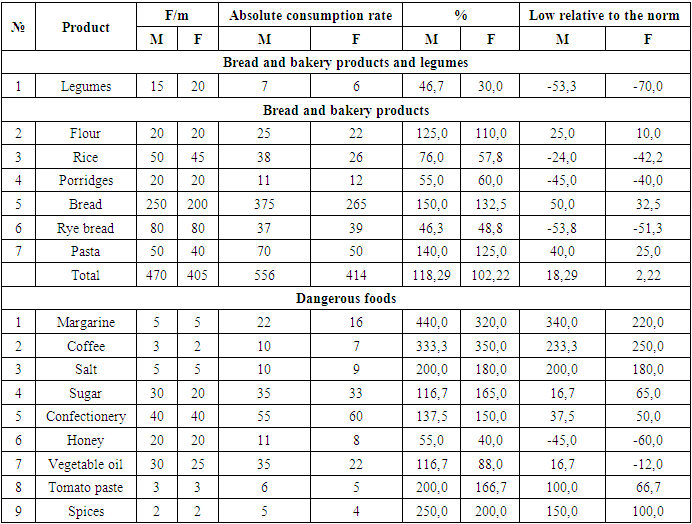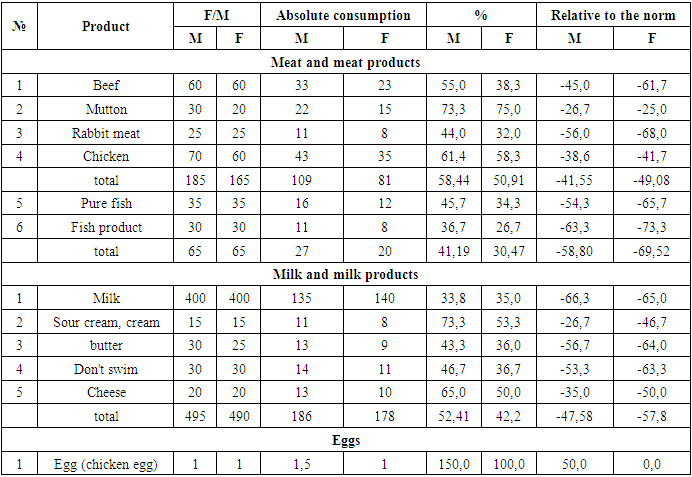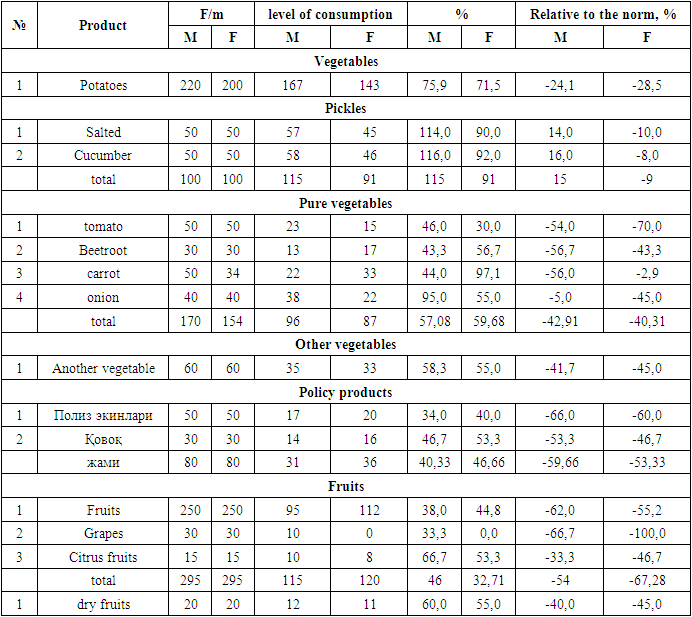-
Paper Information
- Next Paper
- Previous Paper
- Paper Submission
-
Journal Information
- About This Journal
- Editorial Board
- Current Issue
- Archive
- Author Guidelines
- Contact Us
American Journal of Medicine and Medical Sciences
p-ISSN: 2165-901X e-ISSN: 2165-9036
2024; 14(4): 919-925
doi:10.5923/j.ajmms.20241404.26
Received: Mar. 14, 2024; Accepted: Mar. 29, 2024; Published: Apr. 10, 2024

Factor Hygienic Analysis of the Daily Diet in the Spring Period in Patients Suffering with Chronic Glomerulonephritis
Nizom Ermatov1, Abdulkhaeva Zukhrakhon2, Dulta Kenjabayev3
1Head of the Hygiene of Children, Teenagers and Nutrition Department, Tashkent Medical Academy, Tashkent, Uzbekistan
2Department of Hygiene of Children and Adolescents and Food Hygiene, Tashkent Medical Academy, Tashkent, Uzbekistan
3Department of Internal Medicine with a course of occupational diseases at the Tashkent Medical Academy, Tashkent, Uzbekistan
Correspondence to: Nizom Ermatov, Head of the Hygiene of Children, Teenagers and Nutrition Department, Tashkent Medical Academy, Tashkent, Uzbekistan.
| Email: |  |
Copyright © 2024 The Author(s). Published by Scientific & Academic Publishing.
This work is licensed under the Creative Commons Attribution International License (CC BY).
http://creativecommons.org/licenses/by/4.0/

This article presents a hygienic analysis of the composition of the daily diet of patients with chronic glomerulonephritis. An analysis of the daily diet of patients living in the Andijan region at home in the spring season was carried out. The results obtained were assessed for compliance with the requirements of sanitary standards and regulations 0007-2020, and the chemical composition for compliance with the standards “Chemical Composition of Food Products”. The results obtained show that the daily diet of patients does not meet physiological normative indicators and hygienic requirements. The consumption rate of premium bread, flour and pasta as part of the daily diet was sharply increased in representatives of both sexes compared to the norm, and, despite the fact that the total consumption rate of bread and bakery products exceeds 102.22-118.29%, the consumption rate of rye bread, rice and porridge was significantly lower than standard indicators. Of the risk group products, increased consumption of margarine was noted - by 4.4 and 3.2 times a day, coffee - by 3.5-3.3 times, table salt - by 2.0-1.8 times, sugar - by 1.1-1.6 times, confectionery products - 1.5-1.3 times, vegetable oil for men - more than 116.7%. The amount of consumption of meat products was 50.91-58.44%, rabbit meat - 44.0-32.0%, lamb - 73.0-75.0% of the recommended standards. Consumption of fish products was also below standards by 58.8-69.2%. The content in the daily diet is 2.9-2.8% lower than the norm for milk consumption. The level of consumption of sour cream, cream cheese, and buttermilk was also low, and the amount of consumption of dairy products turned out to be 2.6-2.7 times lower than physiological norms. Considering that the norm of carrot consumption is below the norm by 42.91% in men, and by 40.31% in women, in melons - by 34.0-40.0% less than the norm, fruits - by 40.0-45, 0% less than normal, these patients need to use special technologies for preparing rabbit and chicken meat, as well as ensure the formation and adherence to a preventive diet consisting of local plant products, mung beans, beans, peas.
Keywords: Nutrition, Glomerulonephritis, Diet, Bread, Meat, Dairy and fish products, Carrots and fruits
Cite this paper: Nizom Ermatov, Abdulkhaeva Zukhrakhon, Dulta Kenjabayev, Factor Hygienic Analysis of the Daily Diet in the Spring Period in Patients Suffering with Chronic Glomerulonephritis, American Journal of Medicine and Medical Sciences, Vol. 14 No. 4, 2024, pp. 919-925. doi: 10.5923/j.ajmms.20241404.26.
Article Outline
1. Introduction
- Regarding the prevention of chronic diseases among the population in our country, the President of the Republic of Uzbekistan No. PF-60 dated January 28, 2022 "On the development strategy of New Uzbekistan for 2022-2026" [1], No. PQ-4063 dated December 18, 2018 "Prevention of non-communicable diseases, on measures to support a healthy lifestyle and increase the level of physical activity of the population" [2], decisions of November 10, 2020 No. PQ-4887 "On additional measures to ensure the population's healthy diet" [3] and this This research work serves as a basis to a certain extent in the implementation of tasks defined in other regulatory legal documents related to the activity.Eating disorder reduces resistance to the harmful effects of environmental factors and creates conditions for the development of various diseases. These include excess body weight, metabolic syndrome with metabolic diseases, cardiovascular system, kidney diseases, autoimmune diseases and diabetes [4,5,6].Glomerulonephritis-kidney immuno-inflammation with the main involvement of glomerular apparatus is considered a kidney disease, and acute tonsillitis, viral diseases, pneumonia and various paralytic viruses are considered a disease that develops as a result of taking anti-viral drugs [5,6,10,11].In case of kidney diseases, it is advisable to replace meat products with vegetable proteins in the daily ration of hard-to-digest and high-protein products. The amount of gas-forming products together with excessive salty, salty, fried, spicy, confectionery products in the daily diet of patients was estimated [16,17,18,19].Glomerulonephritis is an infectious inflammatory disease of the kidneys affecting the kidney tissues. This is a common disease, which is divided into chronic and acute forms, and there are asymptomatic variants. In this disease, along with active drug therapy, it is important to support appropriate nutrition and follow the principles of curative and preventive nutrition. It should be designed to reduce the burden on the kidneys, replenish the loss of vitamins and trace elements, and provide energy to the body for rapid recovery [16,17,18,19,20].A healthy diet is the basis of a healthy lifestyle. Adherence to a healthy lifestyle and its main components depends not only on increasing the efficiency of working ability among different layers of the population, but also on the prevention of various diseases depending on their age and gender [12,13,14,15].Today, one of the main tasks of modern nutritionology is focused not on the diet of the population, but on the perfect study of the hygienic, medical and biological properties of a specific product. Feeding all layers of the population, especially children and the elderly, with pure quality food products is one of the main criteria aimed not only at improving their health status, reducing alimentary diseases, but also at increasing life expectancy in combination with reducing the impact of environmental risk factors [12,13,14,15,16,17].Hygienic assessment of the diet of patients and patients with chronic glomerulonephritis based on a combination of local plant products is one of the urgent problems facing primary care and field workers.
2. Aim of the Research
- It consists of a hygienic analysis of the daily nutritional status of patients with chronic glomerulonephritis at home in the spring season of the year.
3. Materials and Methods
- Patients and patients aged 18 to 60 years old were taken for the purpose of multifactorial analysis of the daily diet of patients living in Andijan region and suffering from chronic glomerulonephritis. Researches were carried out during 2020-2023. In the spring season of the year (March, April, May), the beginning, middle and end of each month, during the whole season, 81 (9 out of 10) menus were analyzed according to their compositional structure.The patients' daily food intake in all months of the spring season and its physiological composition correspond to the requirements of the current the requirement norm and regulations 0007-2020 "Average daily rational nutrition norms aimed at ensuring healthy nutrition for the population of the Republic of Uzbekistan by age, gender and professional activity groups" [9] and their chemical composition depends on the factor results analyzed on the basis of "Chemical composition of food products" and their obtained results were carried out on the basis of the analysis [7,8].Statistical processing of the research results was done using the "Statistica for Windows 7.0" personal computer application package.
4. Results and Discussion
- In order to find and scientifically analyze the deficiency of the results obtained in the daily diet of patients with acute and chronic glomerulonephritis during the main months and days and its solution, to analyze the daily diet of workers in a separate order in all seasons of the year and to carry out a comparative analysis of the obtained results with physiological normative indicators and seasons We found it appropriate to evaluate the impact of the changes that occurred during the course of the disease on the recurrence and progression of the disease.In the analysis of the diet of patients with chronic glomerulonephritis, in this study we analyzed the consumption ratio of 42 specified products specified in the sanitary norms and rules, which determined the hygienic analysis of the home diet in the winter season of the year, and analyzed them in the order of separation into the main group of products and the products of the xaf group, and its We consider the need to assess the role of the disease in development and to develop conclusions and practical recommendations based on it as a solution to the tasks set before us.In the analysis of food, the working conditions and the eating habits are divided into 5 groups and recommended. Taking this into account, we analyzed the changes in the daily nutritional status of the patients in order to determine the sharp differences, depending on the compliance with the recommended diet for the population of the first group.In the course of this study, patients were analyzed in groups according to their diet and daily consumption, and the main group was bread and bakery products.It's no secret that bread and bread products with a high glycemic index form the basis of the daily diet of not only patients and healthy people living in our region.We aimed at this group to study the products specified in the normative documents in a separate and aggregated manner. The first group of products includes bread and bakery products, which include legumes, flour, rice, porridge, bread, rye bread and macaron, and the results are presented in Table 1.
|
|
|
5. Conclusions
- Based on the analysis of the obtained results, we present the following conclusions:1. The level of consumption of high-quality bread, flour and pasta products in the daily diet of patients with chronic glomerulonephritis is significantly higher in both sexes compared to the norm. the consumption level of rice and porridge is low, it was found that porridge is 40-45% less than the daily norm in the spring season.2. In the daily diet of patients with chronic glomerulonephritis, the level of consumption of margarine from risk group products is very high, 4.4 and 3.2 times a day, coffee 3.5-3.3 times, table salt 2.0-1.8 times, sugar 1.1-1.6 times, consumption level of confectionery products 1.5-1.3 times, vegetable oil 116.7% more in men.3. The level of consumption of common meat products in the daily ration was 50.91-58.44%, rabbit meat was 44.0-32.0%, mutton was 73.0-75.0%. Fish products are undersupplied by 58.8-69.2% in spring.4. The level of consumption of milk in the daily ration is 2.9-2.8% less among the sexes during the spring season. The level of consumption of sour cream, cream cheese, and butter is also very low, and the level of consumption of general dairy products is 2.6-2.7 times lower than physiological norms.5. In the spring season of the year, the daily ration of patients includes 71.5-75.9% of potatoes, 42.91% of vegetables in men, 40.31% in women, the consumption of other vegetables is turnip, radish, radish, Cabbage was 55.0-58.3%, poliza crops were 34.0-40.0%, pumpkin consumption was 46.7-53.0%, and total poliza crops were 2.2 to 2. Less than 5 times.6. In the spring of the year, the average indicator of the level of consumption of fruits is 40.0-45.0% less. The basis of fruits depends on the ratio of apples and seasonal fruits, in the spring strawberries, cherries, and mulberries are formed. was 7%. Consumption of dried fruits is less than 40-45%.
 Abstract
Abstract Reference
Reference Full-Text PDF
Full-Text PDF Full-text HTML
Full-text HTML

